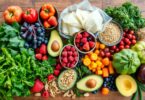
Comprehensive Exploration of Food Classifications
Introduction
Food is an essential aspect of human life, serving not only as a source of sustenance but also as a cultural artifact that shapes societies and communities. Understanding the classifications of food is crucial for making informed dietary choices, enhancing culinary skills, and appreciating the diversity of global cuisines. This essay will explore the various classifications of food, including types, sources, states, occasions, preparation methods, cuisines, nutritional content, dietary habits, seasonal variations, serving styles, health benefits, and packaging methods.
1. Classification by Type
1.1 Healthy Food
Healthy food encompasses a variety of nutrient-rich options that support overall well-being. This category includes:
- Vegetables: Leafy greens (spinach, kale), cruciferous vegetables (broccoli, cauliflower), and root vegetables (carrots, beets).
- Fruits: Berries (strawberries, blueberries), citrus fruits (oranges, lemons), and tropical fruits (mangoes, pineapples).
- Whole Grains: Brown rice, quinoa, oats, and whole wheat products.
1.2 Unhealthy Food
Unhealthy food typically contains high levels of sugar, salt, and unhealthy fats. Common examples include:
- Fast Food: Burgers, fries, and pizza, which are often high in calories and low in nutrients.
- Sweets: Candy, pastries, and ice cream that contribute to excessive sugar intake.
- Fried Foods: Foods that are deep-fried, leading to higher fat content and calorie density.
2. Classification by Source
2.1 Plant-Based Source
Plant-based foods are derived from plants and are vital for a balanced diet:
- Fruits and Vegetables: Essential for vitamins, minerals, and fiber.
- Legumes: Beans, lentils, and peas are excellent sources of protein and fiber.
- Nuts and Seeds: Almonds, walnuts, chia seeds, and flaxseeds provide healthy fats and protein.
2.2 Animal-Based Source
Animal-based foods provide high-quality protein and essential nutrients:
- Meats: Beef, pork, chicken, and lamb are rich in protein, iron, and B vitamins.
- Dairy Products: Milk, cheese, and yogurt offer calcium and protein.
- Eggs: A versatile food rich in protein and nutrients.
3. Classification by State
3.1 Cooked Food
Cooked foods are often more palatable and easier to digest:
- Hot Meals: Dishes served warm, such as soups, stews, and casseroles.
- Baked Goods: Bread, pastries, and cakes that require baking.
3.2 Raw Food
Raw foods are often unprocessed and retain more nutrients:
- Salads: Fresh vegetables and fruits served uncooked.
- Sushi: Raw fish served with rice and vegetables.
4. Classification by Occasion
4.1 Daily Meals
Daily meals are routine and typically consist of:
- Breakfast: The first meal of the day, often including cereals, fruits, or eggs.
- Lunch: A midday meal that may consist of sandwiches, salads, or leftovers.
- Dinner: The evening meal, which can be more elaborate and often includes multiple courses.
4.2 Celebratory Meals
Celebratory meals are linked to special occasions:
- Cakes for Birthdays: Sweet treats that are often decorated and shared among family and friends.
- Traditional Dishes for Holidays: Foods specific to cultural or religious celebrations, such as turkey for Thanksgiving or feasts during Ramadan.
5. Classification by Preparation Method
5.1 Grilled
Grilling enhances flavor and reduces fat:
- Grilled Meats: Chicken, steak, and fish cooked over an open flame or grill.
- Grilled Vegetables: Seasonal vegetables like zucchini, bell peppers, and corn.
5.2 Fried
Frying adds crispiness and flavor:
- French Fries: Potatoes sliced and deep-fried until golden brown.
- Samosas: Pastry filled with spiced potatoes and peas, then deep-fried.
5.3 Boiled
Boiling is a simple cooking method:
- Boiled Vegetables: Carrots, broccoli, and potatoes cooked in water.
- Boiled Eggs: Eggs cooked in water until the desired doneness is achieved.
6. Classification by Cuisine
6.1 Arabic Cuisine
Rich in spices and flavors, Arabic cuisine includes:
- Mansaf: A traditional dish made with lamb, yogurt, and rice.
- Makloubeh: A layered dish of rice, vegetables, and meat.
6.2 Italian Cuisine
Italian cuisine is known for its simplicity and fresh ingredients:
- Pasta: Various shapes served with sauces like marinara or Alfredo.
- Pizza: A flatbread topped with cheese, tomato sauce, and various toppings.
6.3 Asian Cuisine
Diverse and vibrant, Asian cuisine features:
- Noodles: A staple in many Asian cultures, served in soups or stir-fries.
- Sushi: Vinegared rice accompanied by raw fish and vegetables.
7. Classification by Nutritional Content
7.1 Protein-Rich Foods
Protein is essential for muscle growth and repair:
- Meats: Beef, chicken, and turkey are complete protein sources.
- Legumes: Beans and lentils are plant-based protein options.
7.2 Fat-Rich Foods
Healthy fats are important for brain health:
- Nuts: Almonds, walnuts, and cashews provide healthy fats and protein.
- Oils: Olive oil and avocado oil are sources of monounsaturated fats.
7.3 Carbohydrate-Rich Foods
Carbohydrates provide energy:
- Bread: Whole grain bread offers fiber and nutrients.
- Rice: A staple in many cultures, providing a significant source of energy.
8. Classification by Dietary Habits
8.1 Special Diets
Different dietary habits cater to specific needs:
- Vegetarian Diet: Excludes meat but may include dairy and eggs.
- Vegan Diet: Excludes all animal products, focusing on plant-based foods.
8.2 Traditional Foods
Cuisines often reflect cultural heritage:
- Regional Dishes: Foods specific to geographic locations that highlight local ingredients and traditions.
9. Classification by Seasonal Variations
9.1 Seasonal Foods
Certain foods are best consumed during specific seasons:
- Spring: Fresh greens and herbs like asparagus and peas.
- Summer: Berries, tomatoes, and stone fruits like peaches.
9.2 Winter Foods
Comfort foods often feature in winter:
- Soups and Stews: Hearty dishes that provide warmth and nourishment.
10. Classification by Serving Style
10.1 Individual Serving
Some foods are designed for single servings:
- Sandwiches: Convenient for on-the-go meals.
- Salads: Often prepared in individual portions for convenience.
10.2 Family Style
Family-style serving encourages sharing:
- Large Platters: Dishes served in communal bowls for everyone to help themselves.
- Buffets: A variety of dishes presented for guests to choose from.
11. Classification by Health Benefits
11.1 Antioxidant-Rich Foods
Antioxidants help combat oxidative stress:
- Berries: Blueberries and strawberries are high in antioxidants.
- Green Tea: Rich in polyphenols and beneficial compounds.
11.2 Immune-Boosting Foods
Certain foods can enhance the immune system:
- Garlic: Known for its antimicrobial properties.
- Ginger: Helps reduce inflammation and boost immunity.
12. Classification by Packaging Methods
12.1 Fresh Foods
Fresh foods are often unprocessed:
- Fruits and Vegetables: Sold in their natural state without packaging or with minimal packaging.
- Meat and Seafood: Often sold fresh at butcher shops or fish markets.
12.2 Canned and Processed Foods
Canned foods offer convenience and long shelf life:
- Canned Beans: Ready to use in salads or stews.
- Canned Fruits: Convenient for quick snacks or desserts.
Conclusion
Food classifications provide a framework for understanding the complexity of our dietary choices. From the types of food we consume to the cultural significance of different cuisines, these classifications help us navigate the diverse world of food. By exploring these categories, we can make informed decisions that promote health, enhance our culinary experiences, and celebrate the rich tapestry of global food traditions. Ultimately, the way we classify food reflects our values, habits, and lifestyles, shaping our relationship with what we eat.






